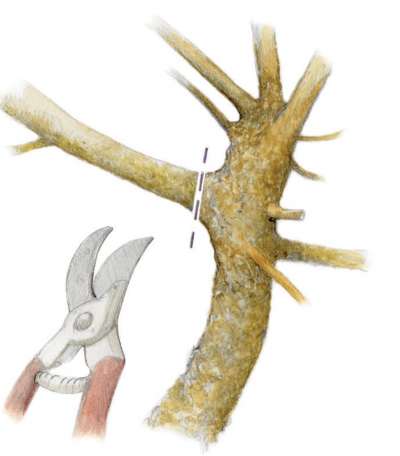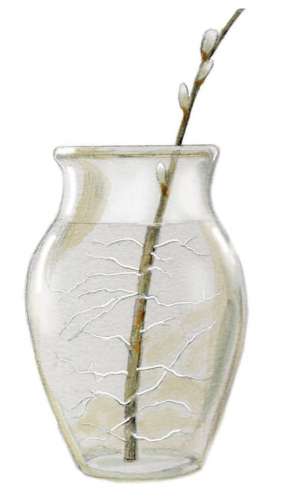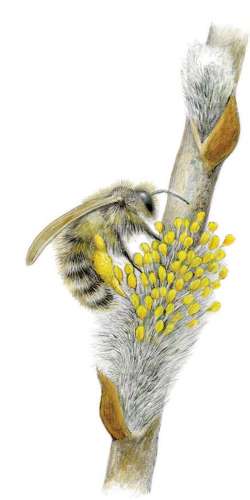
Click here to download a PDF of this article.
Illustrations by Erick Ingraham.
As the year turns toward spring, some of the earliest flowers on the landscape are pussy willows (Salix discolor). These fuzzy catkins are a happy sight, but more important, as a designer of pollinator gardens, I value them as a source of nectar and pollen for early emerging insects. In our region, there are at least 12 species of solitary bees that rely on willows for food. For example, the frigid mining bee (Andrena frigida) is one of the first bees flying in spring. Female frigid mining bees feed exclusively on willow nectar and pollen.
Beyond their value to pollinators, pussy willows and other native willows are important for their leaves, which feed the caterpillars of 397 species of moths and butterflies in our area. In the northern forest ecoregion, willows rank third on the National Wildlife Federation’s list of “keystone” species for the food web, only falling behind oaks and wild cherries.
So how can you grow pussy willows at home? The good news is that the shrubs are very easy to grow from cuttings, a process called propagation, and early spring, before the willows leaf out, is a good time to do this work. Following are some key steps and considerations.
1. Choose your planting site carefully. Pussy willows can grow in average moisture soil in a garden setting, but it’s very important to keep new plantings damp. If young willow roots dry out, the plant will have difficulty getting established. For the first season, the cutting will need to stay well watered at all times. A naturally wet area will spare you watering duties and give the cutting a competitive edge. Keep in mind as well that these shrubs will spread out over time and can grow approximately 25 feet tall. Willow roots seek water and can travel up to 1½ times the plant’s eventual height to find it, so avoid planting close to septic systems, drains, or waterlines.
2. Select an appropriate width and length stem. For example, when restoration crews plant willow species to restore wetlands or to stabilize stream banks, they typically work with larger diameter cuttings that measure at least 2 to 3 feet long, in part because the cuttings will need to stand above competing vegetation. In a typical home landscaping scenario, where a cutting will have little competition from tall plants, a length ranging from approximately 10 inches up to 2 feet, with a ¼- to ¾-inch-thick diameter, is good to work with.
3. Select a young stem, because young stems tend to propagate more easily. In general, these will have smoother bark than older stems.
4. Be careful how you cut the stem, and don’t just cut it halfway down. Instead, follow the stem back to the node where it initially branches off from the trunk or a larger limb and cut there. For the best results, use clean, sharp hand pruners.
5. If possible, you should plant your cutting right away, either by using a dowel or rebar to create a narrow hole in the ground where you can insert the cutting, or by pushing it into the ground (only try this if the soil is soft and the stem is thick enough to handle the pressure). You want stem-to-soil contact, but you should also take care not to compact the soil around your cutting. A good rule of thumb is to plant to a depth of approximately a foot, but this rule is flexible. Eight inches is fine if you’re planting a 10-inch stem. You may need to plant sufficiently deeper for long stems, to add stability so that they don’t fall over. Make sure that the top of the cutting is at least 2 inches above the soil.
6. If it’s not possible to plant your cutting immediately, you can store it for up to a month in the refrigerator. Wrap the cut end in a damp paper towel and cover this in plastic to help avoid desiccation. Alternatively, you can try to root your cutting in water, which can be a fun family project. Place it in a glass container (to allow you to observe its development from the side) filled with 6 to 8 inches of water. Change the water regularly. After the cutting develops roots, plant it outdoors.
Willows make a beautiful addition to home gardens, are easy to grow, and contribute to insect diversity. There’s also another, specific reason to promote them. As Kenrick Vezina’s Outside Story essay reflects, early spring flowers such as willow catkins are vital for healthy bumble bee colonies. Abundant, early access to food leads to bigger worker bees that, because of their size, are more effective foragers.
Better foragers result in faster growing colonies, and bigger colonies produce more young queens at the end of summer. This is the kind of outcome that pollinator-minded gardeners are keen to support, as we try to help reverse recent bee species declines.




Discussion *